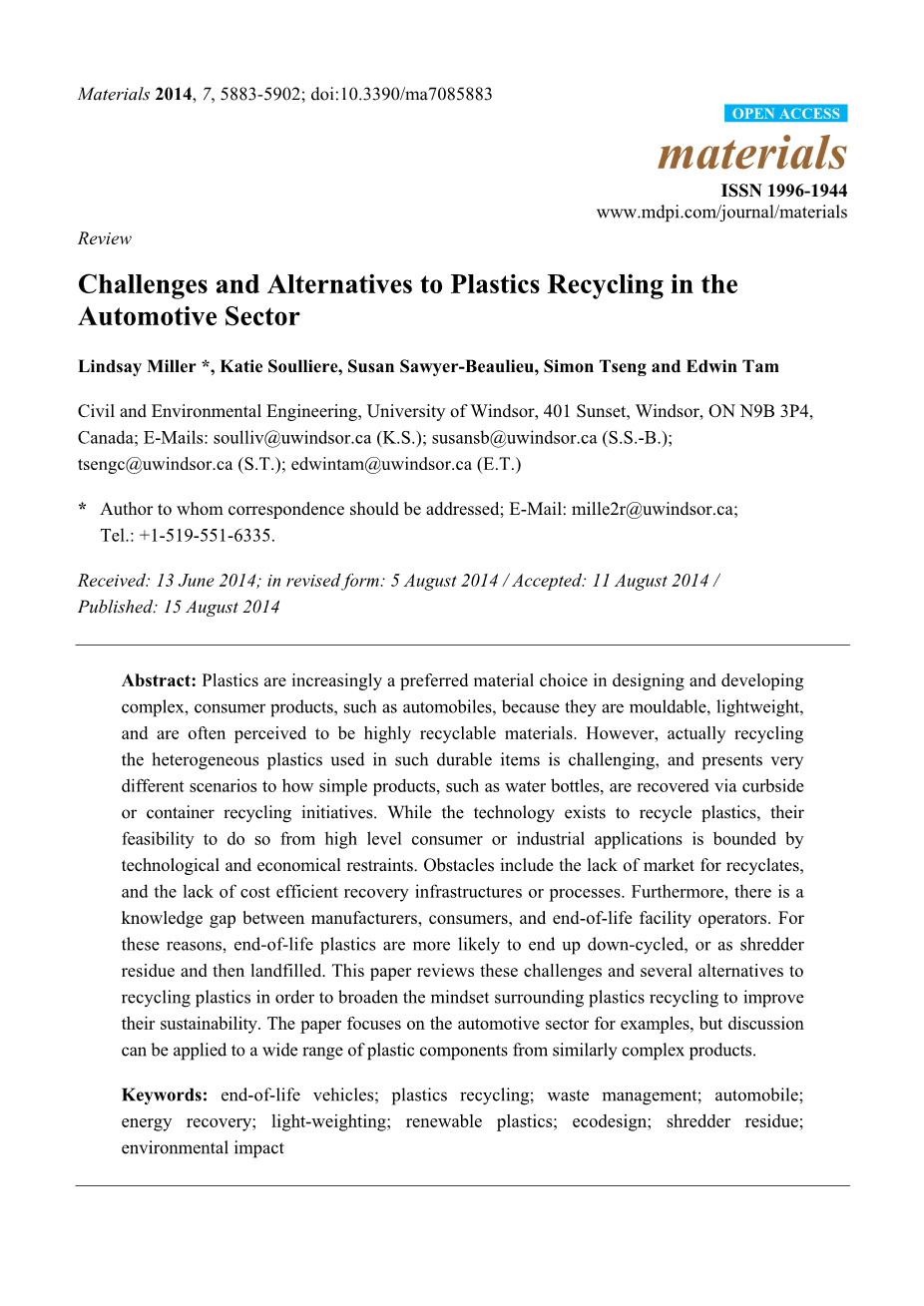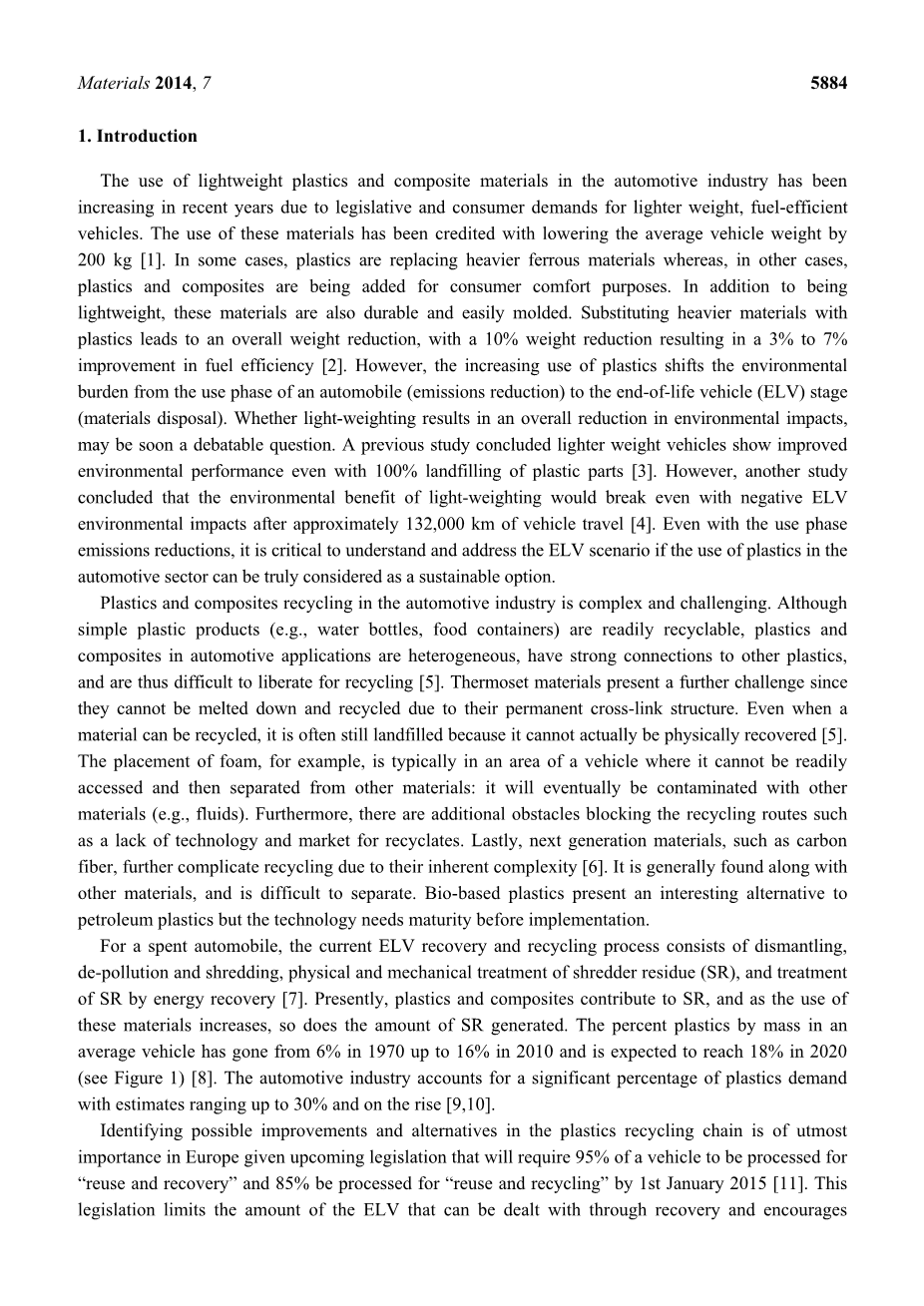

英语原文共 20 页,剩余内容已隐藏,支付完成后下载完整资料
Challenges and Alternatives to Plastics Recycling in the Automotive Sector
Abstract
Plastics are increasingly a preferred material choice in designing and developing complex, consumer products, such as automobiles, because they are mouldable, lightweight, and are often perceived to be highly recyclable materials. However, actually recycling the heterogeneous plastics used in such durable items is challenging, and presents very different scenarios to how simple products, such as water bottles, are recovered via curbside or container recycling initiatives. While the technology exists to recycle plastics, their feasibility to do so from high level consumer or industrial applications is bounded by technological and economical restraints. Obstacles include the lack of market for recyclates, and the lack of cost efficient recovery infrastructures or processes. Furthermore, there is a knowledge gap between manufacturers, consumers, and end-of-life facility operators. For these reasons, end-of-life plastics are more likely to end up down-cycled, or as shredder residue and then landfilled. This paper reviews these challenges and several alternatives to recycling plastics in order to broaden the mindset surrounding plastics recycling to improve their sustainability. The paper focuses on the automotive sector for examples, but discussion can be applied to a wide range of plastic components from similarly complex products.
Keywords: end-of-life vehicles; plastics recycling; waste management; automobile; energy recovery; light-weighting; renewable plastics; ecodesign; shredder residue; environmental impact
Introduction
The use of lightweight plastics and composite materials in the automotive industry has been increasing in recent years due to legislative and consumer demands for lighter weight, fuel-efficient vehicles. The use of these materials has been credited with lowering the average vehicle weight by 200 kg [1]. In some cases, plastics are replacing heavier ferrous materials whereas, in other cases, plastics and composites are being added for consumer comfort purposes. In addition to being lightweight, these materials are also durable and easily molded. Substituting heavier materials with plastics leads to an overall weight reduction, with a 10% weight reduction resulting in a 3% to 7% improvement in fuel efficiency [2]. However, the increasing use of plastics shifts the environmental burden from the use phase of an automobile (emissions reduction) to the end-of-life vehicle (ELV) stage (materials disposal). Whether light-weighting results in an overall reduction in environmental impacts, may be soon a debatable question. A previous study concluded lighter weight vehicles show improved environmental performance even with 100% landfilling of plastic parts [3]. However, another study concluded that the environmental benefit of light-weighting would break even with negative ELV environmental impacts after approximately 132,000 km of vehicle travel [4]. Even with the use phase emissions reductions, it is critical to understand and address the ELV scenario if the use of plastics in the automotive sector can be truly considered as a sustainable option.
Plastics and composites recycling in the automotive industry is complex and challenging. Although simple plastic products (e.g., water bottles, food containers) are readily recyclable, plastics and composites in automotive applications are heterogeneous, have strong connections to other plastics, and are thus difficult to liberate for recycling [5]. Thermoset materials present a further challenge since they cannot be melted down and recycled due to their permanent cross-link structure. Even when a material can be recycled, it is often still landfilled because it cannot actually be physically recovered [5]. The placement of foam, for example, is typically in an area of a vehicle where it cannot be readily accessed and then separated from other materials: it will eventually be contaminated with other materials (e.g., fluids). Furthermore, there are additional obstacles blocking the recycling routes such as a lack of technology and market for recyclates. Lastly, next generation materials, such as carbon fiber, further complicate recycling due to their inherent complexity [6]. It is generally found along with other materials, and is difficult to separate. Bio-based plastics present an interesting alternative to petroleum plastics but the technology needs maturity before implementation.
For a spent automobile, the current ELV recovery and recycling process consists of dismantling, de-pollution and shredding, physical and mechanical treatment of shredder residue (SR), and treatment of SR by energy recovery [7]. Presently, plastics and composites contribute to SR, and as the use of these materials increases, so does the amount of SR generated. The percent plastics by mass in an average vehicle has gone from 6% in 1970 up to 16% in 2010 and is expected to reach 18% in 2020 (see Figure 1) [8]. The automotive industry accounts for a significant percentage of plastics demand with estimates ranging up to 30% and on the rise [9,10].
Identifying possible improvements and alternatives in the plastics recycling chain is of utmost importance in Europe given upcoming legislation that will require 95% of a vehicle to be processed for―reuse and recovery‖ and 85% be processed for ―reuse and recycling‖ by 1st January 2015 [11]. This legislation limits the amount of the ELV that can be dealt with through recovery and encourages recycling whenever environmentally viable. It is expected that by increasing the recycling of plastics from SR, an additional 6%–10% of th
剩余内容已隐藏,支付完成后下载完整资料
资料编号:[237220],资料为PDF文档或Word文档,PDF文档可免费转换为Word
以上是毕业论文外文翻译,课题毕业论文、任务书、文献综述、开题报告、程序设计、图纸设计等资料可联系客服协助查找。


